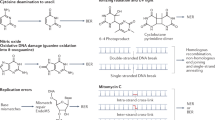Abstract
The 2015 Nobel Prize in Chemistry was awarded jointly to Tomas Lindahl, Paul Modrich and Aziz Sancar to honour their accomplishments in the field of DNA repair. Ever since the discovery of DNA structure and their importance in the storage of genetic information, questions about their stability became pertinent. A molecule which is crucial for the development and propagation of an organism must be closely monitored so that the genetic information is not corrupted. Thanks to the pioneering research work of Lindahl, Sancar, Modrich and their colleagues, we now have an holistic awareness of how DNA damage occurs and how the damage is rectified in bacteria as well as in higher organisms including human beings. A comprehensive understanding of DNA repair has proven crucial in the fight against cancer and other debilitating diseases.
Similar content being viewed by others
Suggested Reading
A Kelner, Effect of visible light on the recovery of Streptomyces griseus conidia from ultraviolet irradiation injury, Proc. Natl. Acad. Sci., USA, Vol.35, pp.73–79, 1949.
G B Sancar, F W Smith, R Reid, G Payne and M Levy, Action mechanism of Escherichia coli DNA photolyase I. Formation of the enzyme-substrate complex, J. Biol. Chem., Vol.262, pp.478–485, 1987.
T Lindahl, B Nyberg, Rate of depurination of native deoxyribonucleic acid, Biochemistry, Vol.11, pp.3610–3618, 1972.
T Lindahl, An N-glycosidase from Escherichia coli that releases free uracil from DNA containing deaminated cytosine residues, Proc. Natl. Acad. Sci., USA, Vol.71, pp.3649–53, 1974.
T Lindahl, New class of enzymes acting on damaged DNA, Nature, Vol.259, pp.64–66, 1976.
G Dianov and T Lindahl, Reconstitution of the DNA base excision-repair pathway, Curr. Biol., Vol.4, pp.1069–1076, 1994.
P Howard-Flanders, R P Boyce, L Theriot, Three loci in Escherichia coli K- 12 that control the excision of pyrimidine dimers and certain other mutagen products from DNA, Genetics, Vol.53, pp.1119–1136, 1966.
A Sancar, W D Rupp, A novel repair enzyme: UVrABC excision nuclease of Escherichia coli cuts a DNA strand on both sides of the damaged region, Cell, Vol.33, pp.249–260, 1983.
R Wagner, M Meselson, Repair tracts in mismatched DNA heteroduplexes, Proc. Natl. Acad., Sci. USA, Vol.73, pp.4135–4139, 1976.
M G Marinus, N R Morris, Pleiotropic effects of a DNA adenine methylation mutation (dam-3) in Escherichia coli K12, Mutat. Res.–Fundam. Mol. Mech. Mutagen., Vol.28, pp.15–26, 1975.
B W Glickman, M Radman, Escherichia coli mutator mutants deficient in methylation-instructed DNA mismatch correction, Proc. Natl. Acad. Sci., USA, Vol.77, pp.1063–1067, 1980.
P J Pukkila, J Peterson, G Herman, P Modrich, M Meselson, Effects of high levels of DNA adenine methylation on methyl-directed mismatch repair in Escherichia coli, Genetics, Vol.104, pp.571–582, 1983.
R S Lahue, K G Au, PModrich, DNA mismatch correction in a defined system. Science, Vol.245, No.4914, pp.160–164, 1989.
Errol C Friedberg, Graham C Walker, Wolfram Siede and Richard D Wood, DNA repair and mutagenesis, 2nd Edition, ASM Press, 2006.
Author information
Authors and Affiliations
Corresponding author
Additional information
D N Rao is a professor at the Department of Biochemistry, Indian Institute of Science, Bengaluru. His research work primarily focuses on DNA interacting proteins in prokaryotes. This includes restriction-modification systems, DNA repair proteins from pathogenic bacteria and and proteins involved in horizontal gene transfer and DNA recombination. Yedu Prasad is a graduate student working on his PhD under the guidance of D N Rao. His thesis work looks into the kinetic mechanism of a novel, phase-variable adenine methyltransferase from H. pylori. He is also working on unraveling the possible roles of this adenine methyltransferase in the physiology and pathogenesis of H. pylori.
Rights and permissions
About this article
Cite this article
Rao, D.N., Prasad, Y. DNA repair systems. Reson 21, 925–936 (2016). https://doi.org/10.1007/s12045-016-0401-x
Published:
Issue Date:
DOI: https://doi.org/10.1007/s12045-016-0401-x




